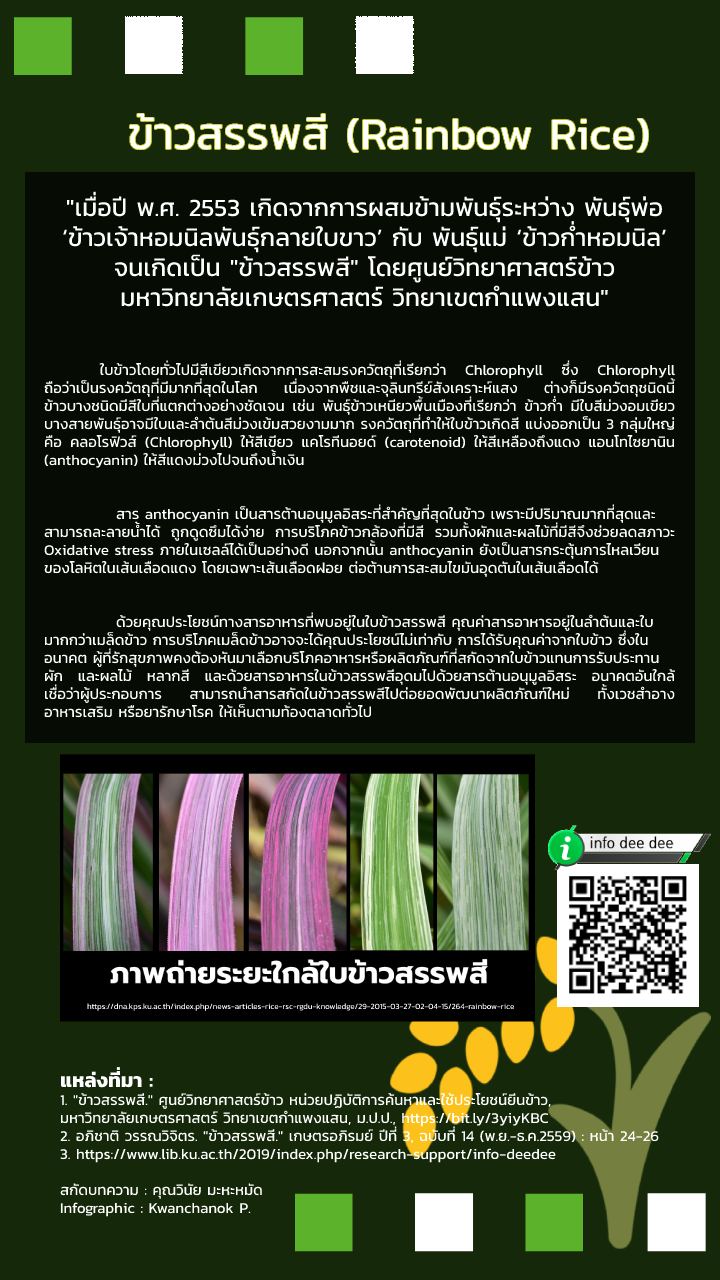ข้าวสรรพสี (Rainbow Rice)
ข้าวสรรพสี (Rainbow Rice)
จากศูนย์วิทยาศาสตร์ข้าว มหาวิทยาลัยเกษตรศาสตร์ วิทยาเขตกำแพงแสน
นายวินัย มะหะหมัด
บรรณารักษ์ชำนาญการ
ผู้เรียบเรียง

ข้าวสรรพสี ข้าวกล้องสีเข็มมีลายคล้ายรุ้ง อุดมไปด้วยสารต้านอนุมูลอิสระ สีเขียว คลอโรฟิวส์ (Chlorophyll) สีเหลืองถึงแดง
แคโรทีนอยด์ (carotenoid) สีแดงม่วงไปจนถึงน้ำเงิน แอนโทไซยานิน (anthocyanin) ซึ่งเป็นสารสำคัญที่อยู่ในข้าวสรรพสี [1]
จากการพัฒนาพันธุ์พืชสู่นวัตกรรมอาหาร [1]
1) จากการผสมข้ามสายพันธุ์ข้าวสองสายพันธุ์ ในปี พ.ศ. 2553
- ข้าวเจ้าหอมนิลพันธุ์กลายใบขาว (พันธ์พ่อ)
- ข้าวก่ำหอมนิล (พันธ์แม่)
2) กำเนิดข้าวสรรพสีสายพันธุ์ใหม่ ปี 2559
ด้วยลำต้นมีใบที่สีสวยงาน สีเขียวสลับขาว ชมพู ม่วง สีโดดเด่นชัดเจน
ข้าวสรรพสีสายพันธุ์ทั้ง 5 สายพันธุ์ [2]
“1) สายพันธุ์ใบสีชมพูทับทิมต้นสูง (สรรพสี 01),
2) ใบสีชมพูทับทิมต้นเตี้ย (สรรพสี 02),
3) ใบสีชมพูแถบเขียวและขาวต้นสูง (สรรพสี 03),
4) ใบสีชมพูแถบเขียวและขาวต้นเตี้ย (สรรพสี 04)
5) ใบสีขาว (สรรพสี 05)”
ด้วยคุณประโยชน์ทางสารอาหารที่พบอยู่ในใบข้าวสรรพสี คุณค่าสารอาหารอยู่ในลำต้นและใบมากกว่าเมล็ดข้าว การบริโภคเมล็ดข้าวอาจจะได้คุณประโยชน์ไม่เท่ากับ การได้รับคุณค่าจากใบข้าว ซึ่งในอนาคตผู้ที่รักสุขภาพคงต้องหันมาเลือกบริโภคอาหารหรือผลิตภัณฑ์ที่สกัดจากใบข้าวแทน
การรับประทานผักและผลไม้หลากสี และด้วยสารอาหารในข้าวสรรพสีอุดมไปด้วยสารต้าน
อนุมูลอิสระ อนาคตอันใกล้เชื่อว่าผู้ประกอบการสามารถนำสารสกัดในข้าวสรรพสีไปต่อยอดพัฒนาผลิตภัณฑ์ใหม่ ทั้งเวชสำอาง อาหารเสริม หรือยารักษาโรคให้เห็นตามท้องตลาดทั่วไป
แหล่งที่มา:
1. "ข้าวสรรพสี." ศูนย์วิทยาศาสตร์ข้าว หน่วยปฏิบัติการค้นหาและใช้ประโยชน์ยีนข้าว, มหาวิทยาลัยเกษตรศาสตร์ วิทยาเขตกำแพงแสน, ม.ป.ป., https://dna.kps.ku.ac.th/index.php/news-articles-rice-rsc-rgdu-knowledge/29-2015-03-27-02-04-15/264-rainbow-rice
2. อภิชาติ วรรณวิจิตร. "ข้าวสรรพสี." เกษตรอภิรมย์ ปีที่ 3, ฉบับที่ 14 (พ.ย.-ธ.ค.2559) : หน้า 24-26
http://www.agri.kps.ku.ac.th/kasetapirom
แนะนำแหล่งสารสนเทศที่เกี่ยวข้อง
Reference
Afzal, J., M. H. Saleem, F. Batool, A. M. Elyamine, M. S. Rana, A. Shaheen, M. A. El-Esawi, et al. "Role of Ferrous Sulfate (Feso4) in Resistance to Cadmium Stress in Two Rice (Oryza Sativa L.) Genotypes." Biomolecules 10, no. 12 (2020): 1-27. https://doi.org/10.3390/biom10121693.
Banerjee, A., and A. Roychoudhury. "Maghemite Nano-Fertilization Promotes Fluoride Tolerance in Rice by Restoring Grain Yield and Modulating the Ionome and Physiome." Ecotoxicology and Environmental Safety 215 (2021). https://doi.org/10.1016/j.ecoenv.2021.112055.
Callcott, E. T., A. B. Santhakumar, J. Luo, and C. L. Blanchard. "Therapeutic Potential of Rice-Derived Polyphenols on Obesity-Related Oxidative Stress and Inflammation." Journal of Applied Biomedicine 16, no. 4 (2018): 255-62. https://doi.org/10.1016/j.jab.2018.03.001.
Chaiyasut, C., B. S. Sivamaruthi, N. Pengkumsri, W. Keapai, P. Kesika, M. Saelee, P. Tojing, et al. "Germinated Thai Black Rice Extract Protects Experimental Diabetic Rats from Oxidative Stress and Other Diabetes-Related Consequences." Pharmaceuticals 10, no. 1 (2017). https://doi.org/10.3390/ph10010003.
Cullen, A. E., A. M. Centner, R. Deitado, J. Fernandez, and G. Salazar. "The Impact of Dietary Supplementation of Whole Foods and Polyphenols on Atherosclerosis." Nutrients 12, no. 7 (2020): 1-36. https://doi.org/10.3390/nu12072069.
Gong, E. S., C. Liu, B. Li, W. Zhou, H. Chen, T. Li, J. Wu, et al. "Phytochemical Profiles of Rice and Their Cellular Antioxidant Activity against Abap Induced Oxidative Stress in Human Hepatocellular Carcinoma Hepg2 Cells." Food Chemistry 318 (2020). https://doi.org/10.1016/j.foodchem.2020.126484.
Guo, H., W. Ling, Q. Wang, C. Liu, Y. Hu, M. Xia, X. Feng, and X. Xia. "Effect of Anthocyanin-Rich Extract from Black Rice (Oryza Sativa L. Indica) on Hyperlipidemia and Insulin Resistance in Fructose-Fed Rats." Plant Foods for Human Nutrition 62, no. 1 (2007): 1-6. https://doi.org/10.1007/s11130-006-0031-7.
Li, X., and T. Zhang. "Effects of Anthocyanins from Black Rice on Spatial Learning and Memory in Mice Fed with High Fat Diet." Journal of Food Science and Technology (China) 38, no. 5 (2020): 78-84. https://doi.org/10.3969/j.issn.2095-6002.2020.05.010.
Li, X., Z. Zhang, X. Zhang, J. Cheng, D. Liu, Y. Yan, and H. Wang. "Transcriptomic Analysis of the Life-Extending Effect Exerted by Black Rice Anthocyanin Extract in D. Melanogaster through Regulation of Aging Pathways." Experimental Gerontology 119 (2019): 33-39. https://doi.org/10.1016/j.exger.2019.01.015.
Peng, C., X. Wang, J. Chen, R. Jiao, L. Wang, Y. M. Li, Y. Zuo, et al. "Biology of Ageing and Role of Dietary Antioxidants." BioMed Research International 2014 (2014). https://doi.org/10.1155/2014/831841.
Poomanee, W., P. Doungsaard, N. Nantharat, and P. Leelapornpisid. "Evaluation of Biological Activities and Stability of Thai Organic Riceberry Broken Rice Extracts for the Anti-Aging Cosmetology." International Journal of Applied Pharmaceutics 13, no. special issue 1 (2021): 1-4. https://doi.org/10.22159/ijap.2021.v13s1.Y0027.
Sangkitikomol, W., T. Tencomnao, and A. Rocejanasaroj. "Antioxidant Effects of Anthocyanins-Rich Extract from Black Sticky Rice on Human Erythrocytes and Mononuclear Leukocytes." African Journal of Biotechnology 9, no. 48 (2010): 8222-29. https://doi.org/10.5897/ajb10.827.
———. "Effects of Thai Black Sticky Rice Extract on Oxidative Stress and Lipid Metabolism Gene Expression in Hepg2 Cells." Genetics and Molecular Research 9, no. 4 (2010): 2086-95. https://doi.org/10.4238/vol9-4gmr912.
Sebastian, A., and M. N. V. Prasad. "Red and Blue Lights Induced Oxidative Stress Tolerance Promote Cadmium Rhizocomplexation in Oryza Sativa." Journal of Photochemistry and Photobiology B: Biology 137 (2014): 135-43. https://doi.org/10.1016/j.jphotobiol.2013.12.011.
Speer, Hollie, Nathan M. D'Cunha, Natalie I. Alexopoulos, Andrew J. McKune, and Nenad Naumovski. "Anthocyanins and Human Health-a Focus on Oxidative Stress, Inflammation and Disease." [In eng]. Antioxidants (Basel, Switzerland) 9, no. 5 (2020): 366. https://doi.org/10.3390/antiox9050366.
Tan, X. W., M. Bhave, A. Y. Y. Fong, E. Matsuura, K. Kobayashi, L. H. Shen, and S. S. Hwang. "Cytoprotective and Cytotoxic Effects of Rice Bran Extracts in Rat H9c2(2-1) Cardiomyocytes." Oxidative Medicine and Cellular Longevity 2016 (2016). https://doi.org/10.1155/2016/6943053.
Toyokuni, S., T. Itani, Y. Morimitsu, K. Okada, M. Ozeki, S. Kondo, K. Uchida, et al. "Protective Effect of Colored Rice over White Rice on Fenton Reaction-Based Renal Lipid Peroxidation in Rats." Free Radical Research 36, no. 5 (2002): 583-92. https://doi.org/10.1080/10715760290025960.
Watanabe, M. "Effects of Black Rice Containing Anthocyanins on Plasma and Hepatic Parameters in Type 2 Diabetic Db/Db Mice." Food Science and Technology Research 22, no. 5 (2016): 719-25. https://doi.org/10.3136/fstr.22.719.

